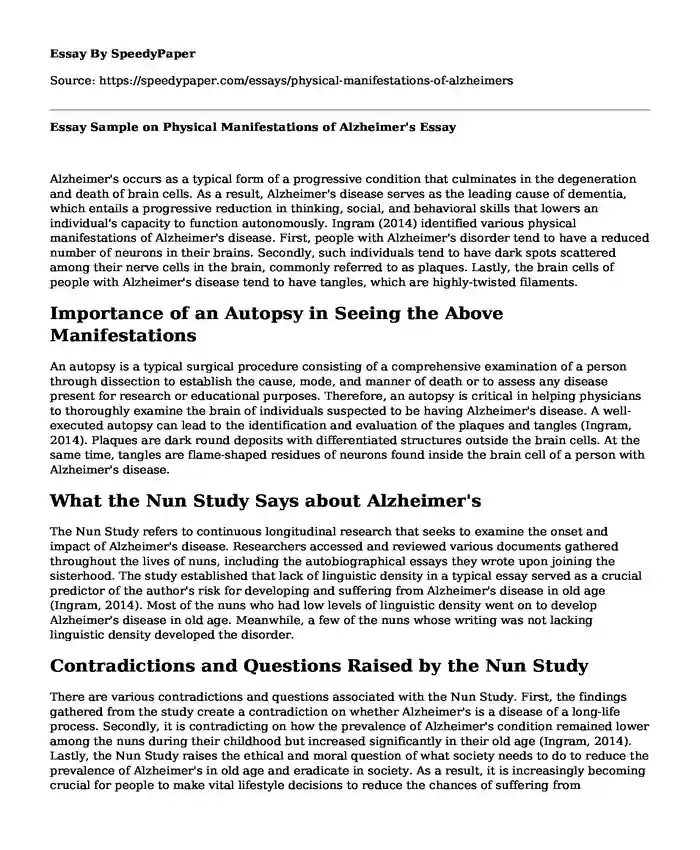
| Type of paper: | Essay |
| Categories: | Medicine Mental disorder Dementia |
| Pages: | 2 |
| Wordcount: | 504 words |
Alzheimer's occurs as a typical form of a progressive condition that culminates in the degeneration and death of brain cells. As a result, Alzheimer's disease serves as the leading cause of dementia, which entails a progressive reduction in thinking, social, and behavioral skills that lowers an individual's capacity to function autonomously. Ingram (2014) identified various physical manifestations of Alzheimer's disease. First, people with Alzheimer's disorder tend to have a reduced number of neurons in their brains. Secondly, such individuals tend to have dark spots scattered among their nerve cells in the brain, commonly referred to as plaques. Lastly, the brain cells of people with Alzheimer's disease tend to have tangles, which are highly-twisted filaments.
Importance of an Autopsy in Seeing the Above Manifestations
An autopsy is a typical surgical procedure consisting of a comprehensive examination of a person through dissection to establish the cause, mode, and manner of death or to assess any disease present for research or educational purposes. Therefore, an autopsy is critical in helping physicians to thoroughly examine the brain of individuals suspected to be having Alzheimer's disease. A well-executed autopsy can lead to the identification and evaluation of the plaques and tangles (Ingram, 2014). Plaques are dark round deposits with differentiated structures outside the brain cells. At the same time, tangles are flame-shaped residues of neurons found inside the brain cell of a person with Alzheimer's disease.
What the Nun Study Says about Alzheimer's
The Nun Study refers to continuous longitudinal research that seeks to examine the onset and impact of Alzheimer's disease. Researchers accessed and reviewed various documents gathered throughout the lives of nuns, including the autobiographical essays they wrote upon joining the sisterhood. The study established that lack of linguistic density in a typical essay served as a crucial predictor of the author's risk for developing and suffering from Alzheimer's disease in old age (Ingram, 2014). Most of the nuns who had low levels of linguistic density went on to develop Alzheimer's disease in old age. Meanwhile, a few of the nuns whose writing was not lacking linguistic density developed the disorder.
Contradictions and Questions Raised by the Nun Study
There are various contradictions and questions associated with the Nun Study. First, the findings gathered from the study create a contradiction on whether Alzheimer's is a disease of a long-life process. Secondly, it is contradicting on how the prevalence of Alzheimer's condition remained lower among the nuns during their childhood but increased significantly in their old age (Ingram, 2014). Lastly, the Nun Study raises the ethical and moral question of what society needs to do to reduce the prevalence of Alzheimer's in old age and eradicate in society. As a result, it is increasingly becoming crucial for people to make vital lifestyle decisions to reduce the chances of suffering from Alzheimer's. Such choices include regular exercise, a healthy and balanced diet, and avoiding alcohol drinking as well as substance abuse.
References
Ingram, J. (2014). The end of memory: A natural history of aging and Alzheimer's. New York: Thomas Dunne Books, St. Martin's Press.
Cite this page
Essay Sample on Physical Manifestations of Alzheimer's. (2023, Mar 22). Retrieved from https://speedypaper.com/essays/physical-manifestations-of-alzheimers
Request Removal
If you are the original author of this essay and no longer wish to have it published on the SpeedyPaper website, please click below to request its removal:
- Free Essay on Change Management Models
- Free Essay Describing the Influence of Jimi Hendrix on Rock and Roll
- Audition - Free Essay on Sensation for You
- Free Essay Dedicated to the Commercial Mandate of the Film Industry
- Free Essay Example about Employees' Discrimination
- Museum Review Essay Sample
- CBT From a Christian Perspective - Free Essay Example
Popular categories




